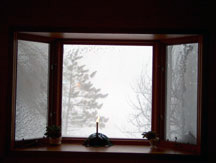What Shall I Give Thee
Mary Jo Loebig, O.C.D.
It was said of John Henry Newman that what he most desired was to have someone tell him what he already knew deep down inside.
As I look out the window at the expanse of neatly trimmed fields quietly awaiting the onset of winter I, too, have a desire much like that of Newman. At this moment, I am wondering just how I will know that Christmas has happened within me this year. My own question reminds me of a Hasidic tale, told with different variants to fit the situation. A rabbi once asked his students how they would know that dawn had come, the hour when night ends and the day begins. One of the students said that he would know that dawn had come when he was able to distinguish a sheep on the hill from a bush nearby. This was not the answer. A second student thought that perhaps it was dawn when, from a distance, he was able to discern s fig tree from a grape vine. That, too, was not the answer. Finally, the rabbi said to them: “When you look into the face of another human being and you have enough light inside of you to recognize this person as your sister or brother, it is then that dawn has come.”
A Candle On The Ledge
As I return to my spot by the window, I know that soon a candle will be placed there on the ledge. I know, too, that down the road a mile or so, the house near Four Corners will also have a candle in its window. It happens every year. In recent years, however, it seems like candles appear in all of its windows, not just one. What a picture it would be to see all the candles that might be burning all over the land and all over the world! What appears to be such a small act does indeed mirror the yearning in our hearts. Truly, great things can come about from small beginnings.
Each year, I find myself meditating on the meaning of the candle in the window. It is probably more accurate to speak of the window in my heart. In Victorian times, candles were put in the window to welcome the stranger. Such a gesture of hospitality was a reaching out to the poor and disadvantaged, and an invitation to come in to warmth, shelter and friendship. Indeed, at Christmas, all the world is kin. On the other hand, some of us may recall from grade school that the lighted candle in the window was put there to show the Christ Child the way. Now, many years later, there is still something within us that yearns for that Christ Child to come.
At any rate, it seems like Christmas time is a good time to meditate on the stranger we might be welcoming. Sometimes, I wonder if there was a stranger at the crib, not mentioned in the Christmas story, a stranger who ended up following the shepherds, or who just found his or her own way to the stable. I find myself saying, “Who is this stranger? How shall I recognize him or her?” I also wonder if I will have enough light within me to recognize the real identity of this wayfarer knocking at my door. And, at this moment, will Christmas really happen to me? It is also possible that the stranger will come in a guise I will not readily discern.
While it is true that, sometimes, I see the stranger as a person, at other times, I think of the stranger as an affect or as an issue or condition that has entered my life, and not as a person per se. I am referring to the stranger who might be visiting us in the guise of pain and illness, loss, abandonment, anxiety, grief,
homesickness, or disappointment.God Wants To Be Born
After we have come to relate to the stranger in our house, the only place to go after that is to the manger and to be there with the shepherds from the hillside, and to place before the Child our pain, our grief, our disappointment, or whatever else. God so wants to be born into the areas where we are hurting. Will we have enough light within us to recognize that Christmas is happening at this moment?
Jessica Powers, a Carmelite poet of our day, exercises a similar motif in her poem, Michigan Boulevard, Chicago. Although Jessica does not use the term as such, it is clear that, through the years, she has met the stranger within. As she reminisces, she sees a star above the street. It is her star. Now a wise and fire-tried woman, the poem reflects her life situation when she first came to this city in her youth, years ago. She had come bearing gifts of hunger, loneliness and poverty. It was a snowy night. She writes that she did not go to the inmost place where the Child lay asleep. Instead, seeing tears upon the Mother’s face, she gave the gifts to her. The night ended in a golden blur, made with the tears of both of them upon their faces, tears of relief, comfort and communion.
What gladness for those who will see God
with their own eyes.Romance 9
Subscription Form | J&J Main Page | Contents Page
